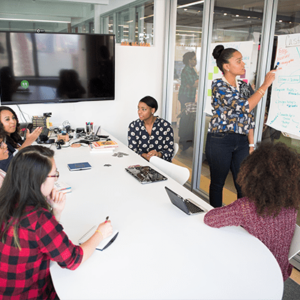Featured Workshop Topics
The topics below can be covered quickly in a half-day overview, or in-depth through an intensive two week program. Topics can be mixed and matched to meet your organization’s needs. And, whether you choose a general introduction, or an intensive deep dive, the workshop will be energizing, challenging, active, and fun.
Leading Innovation
How do you lead innovation?
Leading a group through an innovation project is a challenging process that is much different than other types of work. The skills that let you succeed and rise in ta company may not serve you well when you’re leading innovation, and can even lead you to make exactly the wrong decisions.
What makes this more complex is that there is no single approach to innovation. Sometimes you need to sail fo rblue oceans, while other times require your to adopt disruptive new technology. Sometimes all that’s needed is an incremental improvement to a current product line, but often you need to uncover latent needs through an intensive field research effort.
This workship helps you understand the different types of innovation, when to use each, and how to lead a team through each. It will teach you a proven and dependable set of innovation techniques and give you a roadmap for putting them together. Through lectures, case studies, hands-on activities, and a smartphone-based simulation, you’ll learn a set of tried-and-true methods for leading innovation.
This program is designed for team leaders and product managers, and also for the mid-level and senior managers who have to supervise them.
This interactive program will give participants:
Innovate and improve existing products
How to Revive Mature Products
How do you innovate and improve existing products or services? If all you create is incremental improvements, you’ll quickly become a commodity. But revolutionary, disruptive innovation is often expensive, difficult, and prone to failure.
This workshop focuses on a third type of innovation that is neither incremental nor disruptive. It’s an approach that many successful companies such as USAA, Sherwin-Williams, LEGO, Victoria’s Secret, Novo Nordisk, Gatorade, and Logitech have used to revive challenged products in mature markets. This low-risk, high-reward strategy is an approach to innovation that all company leaders should understand so that they can recognize it when their competitors practice it and apply it when it will give them a competitive advantage.
Through lectures, case studies, hands-on activities, and an innovation simulation, you’ll learn a set of proven techniques for mastering this approach to innovation. Integrated with these techniques is MIT’s unique Distributed Leadership Model—an impactful leadership framework based on four capabilities that support leaders who need to be creative and adaptive in new and unexpected ways. This model will help you deliver value-creating innovation and leverage the leadership capacity that exists throughout your organization.
Getting the Most from Design Thinking
Learn the traps that sabotage
Many companies have invested a great deal in Design Thinking training, with some notable successes. But are you getting the most from your investment? Teams trying to execute their new Design Thinking skills in their company’s existing environment often experience frustration and failure. Practices that help a company succeed in traditional product development will unintentionally sabotage a broader Design Thinking effort. Specifically, there are seven traps that teams fall into when they bring back Design Thinking techniques to their companies:
In this workshop, you’ll learn about these traps, understand how each could affect your Design Thinking process, and learn how to address them. This interactive program will give you:
Innovation Tournaments
a proven method for generating more and better ideas
Tournaments are a proven method for generating more and better ideas for new products and services. But not all tournaments are successful – there are nine different decisions that have to be made, and a wrong choice can cause a tournament to become an expensive disaster. This workshop will teach the science of innovation tournaments and give everyone a chance to apply those lessons by participating in an actual tournament. By the end of this workshop you’ll have learned how tournaments can be structured, where problems can occur, and how you can develop a successful tournament for your company.
Enterprise Architecture as Strategy
A clear roadmap for moving forward
Defining an enterprise architecture (EA) is crucial for the successful implementation of any new system or technology. EA provides a comprehensive framework for data standards, process integration, and security that enables the seamless deployment and integration of advanced technologies, which is necessary for the successful execution of any strategy. A well-defined EA also provides a stable foundation that enables future innovation.
David Robertson is an expert on enterprise architecture. He is co-author of the most influential book on EA, Enterprise Architecture as Strategy. The book, published by Harvard Business School Press, has sold over 130,000 copies and defined the industry standard frameworks and processes for designing and implementing an enterprise architecture. In this workshop, Robertson will lead your team through the following topics:
The result will be a clearer understanding of the decisions that have to be made, the benefits of a good EA, and a roadmap for moving forward.
